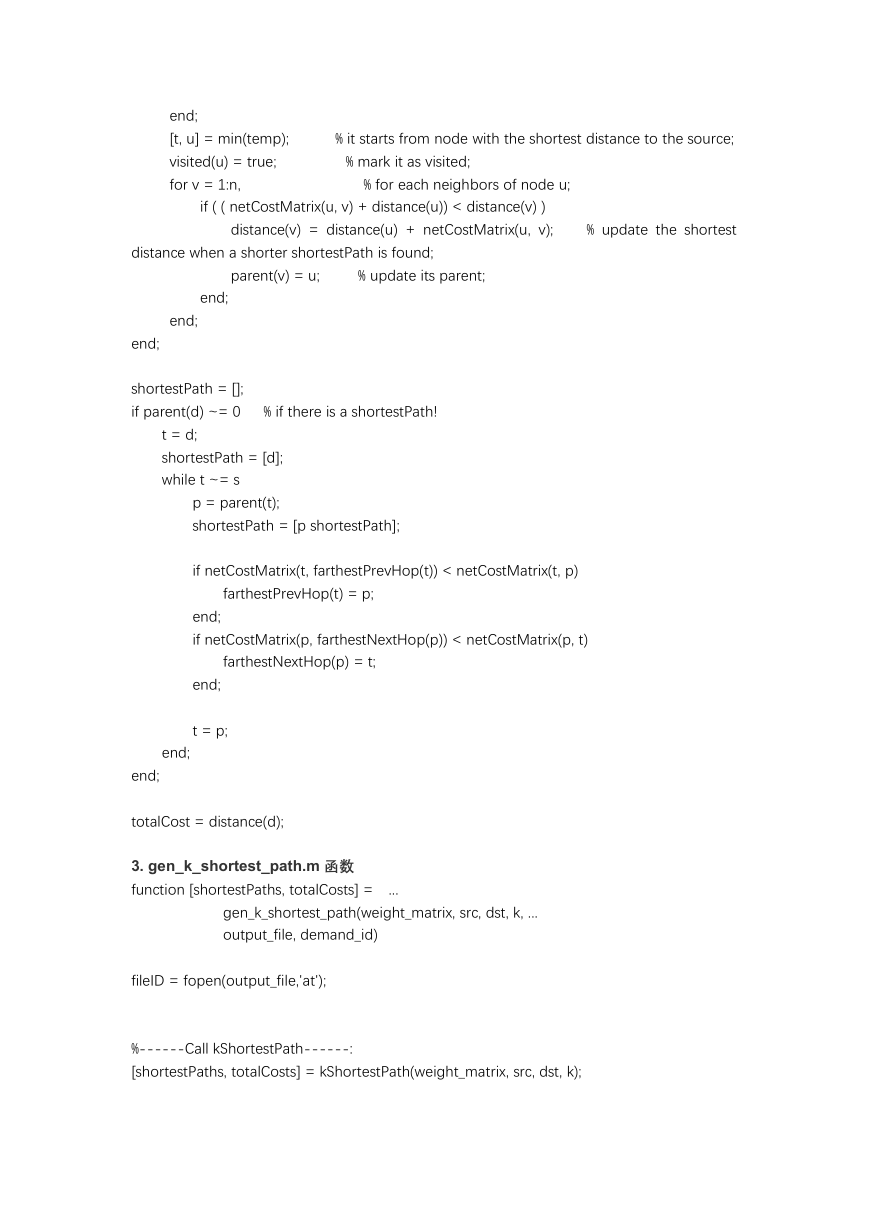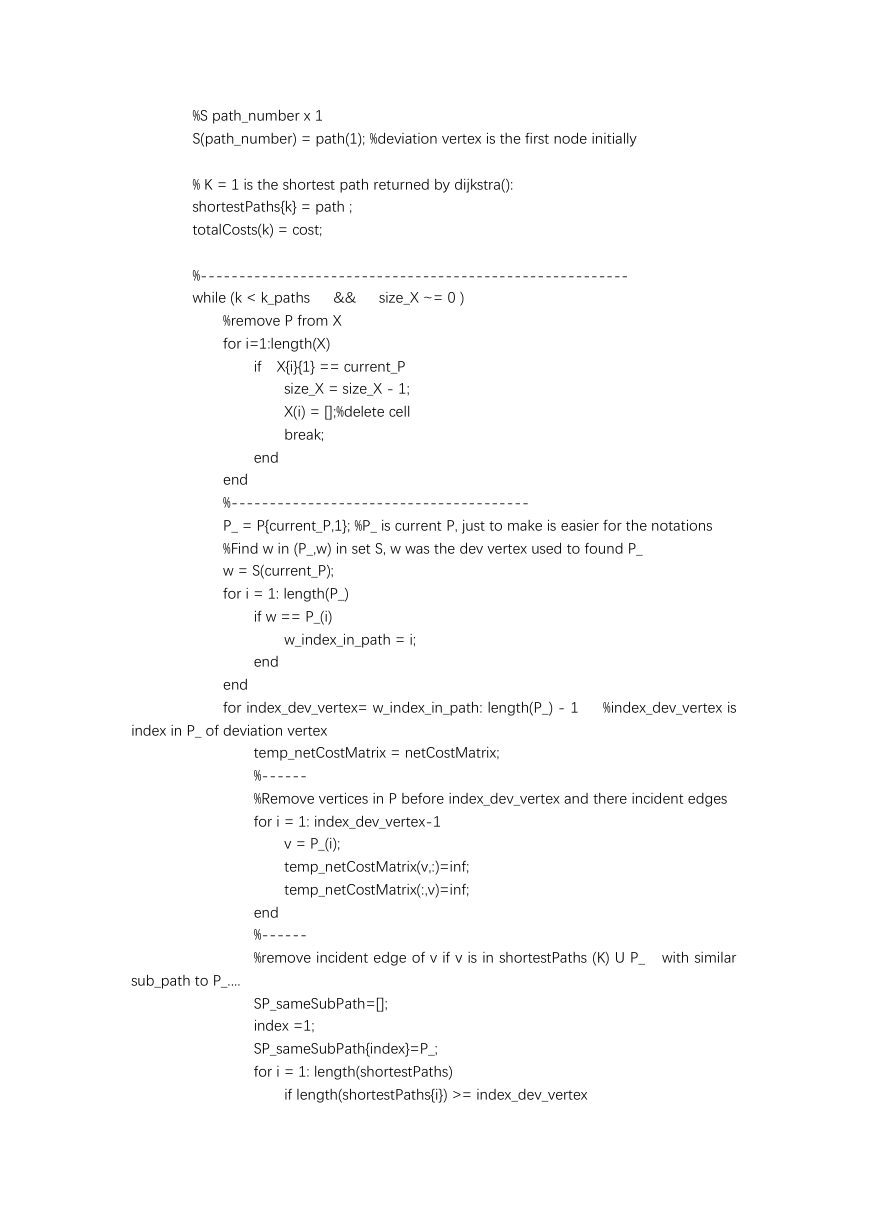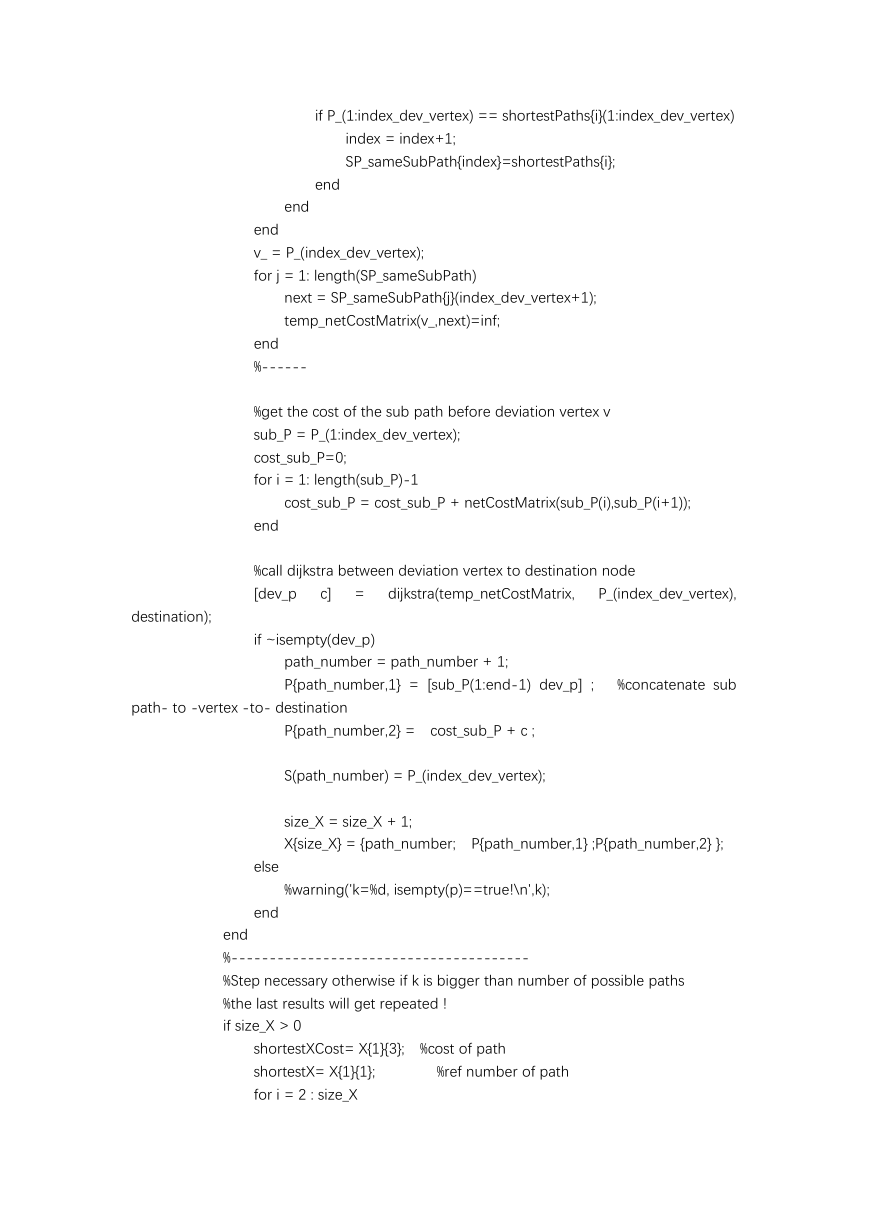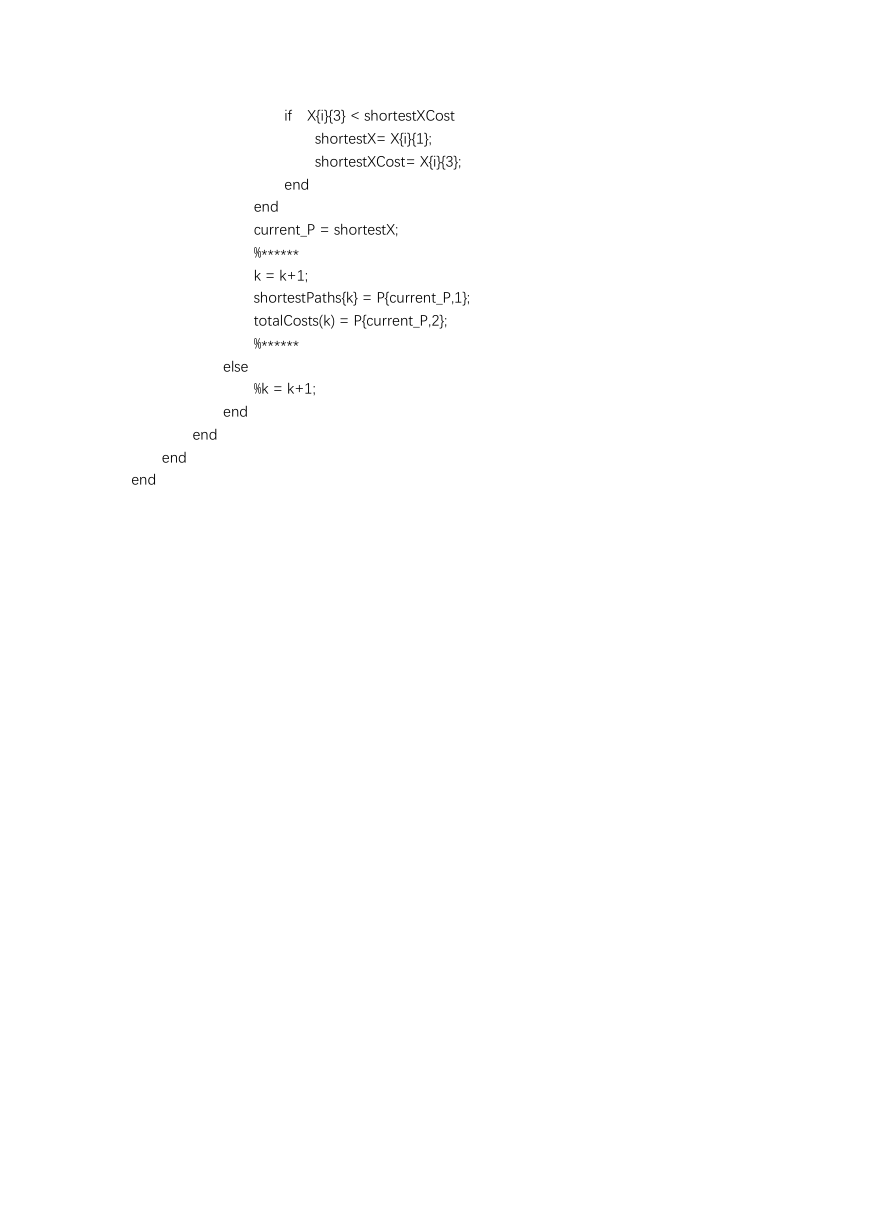1. all_paths_gen.m 函数
function [ ] = all_paths_gen(weight_matrix, k, output_file)
len = length(weight_matrix);
fileID = fopen(output_file,'wt');
fprintf(fileID,'%d nodes \n\n', len);
fclose(fileID);
node_pairs = combnk(1:len,2);
for index = 1: length(node_pairs)
src = node_pairs(index, 1);
dst = node_pairs(index, 2);
gen_k_shortest_path(weight_matrix, src, dst, k, output_file, index);
end
2. dijkstra.m 函数
function [shortestPath, totalCost] = dijkstra(netCostMatrix, s, d)
n = size(netCostMatrix,1);
for i = 1:n
% initialize the farthest node to be itself;
farthestPrevHop(i) = i; % used to compute the RTS/CTS range;
farthestNextHop(i) = i;
end
% all the nodes are un-visited;
visited(1:n) = false;
% it stores the shortest distance between each node and the source
distance(1:n) = inf;
node;
parent(1:n) = 0;
distance(s) = 0;
for i = 1:(n-1),
temp = [ ];
for h = 1:n,
if ~visited(h)
% in the tree;
temp=[temp distance(h)];
else
end
temp=[temp inf];
�
end;
[t, u] = min(temp);
visited(u) = true;
for v = 1:n,
% it starts from node with the shortest distance to the source;
% mark it as visited;
% for each neighbors of node u;
if ( ( netCostMatrix(u, v) + distance(u)) < distance(v) )
distance(v) = distance(u) + netCostMatrix(u, v);
% update the shortest
distance when a shorter shortestPath is found;
parent(v) = u;
% update its parent;
end;
end;
end;
shortestPath = [];
if parent(d) ~= 0
% if there is a shortestPath!
t = d;
shortestPath = [d];
while t ~= s
p = parent(t);
shortestPath = [p shortestPath];
if netCostMatrix(t, farthestPrevHop(t)) < netCostMatrix(t, p)
farthestPrevHop(t) = p;
end;
if netCostMatrix(p, farthestNextHop(p)) < netCostMatrix(p, t)
farthestNextHop(p) = t;
end;
t = p;
end;
end;
totalCost = distance(d);
3. gen_k_shortest_path.m 函数
function [shortestPaths, totalCosts] = ...
gen_k_shortest_path(weight_matrix, src, dst, k, ...
output_file, demand_id)
fileID = fopen(output_file,'at');
%------Call kShortestPath------:
[shortestPaths, totalCosts] = kShortestPath(weight_matrix, src, dst, k);
�
%------Display results------:
if isempty(shortestPaths)
fprintf(fileID,'No path available between these nodes\n\n');
else
for i = 1: length(shortestPaths)
%fprintf(fileID,'Path # %d: %d %d : ',i, src, dst);
fprintf(fileID,'%d %d ', src, dst);
%disp(shortestPaths{i});
len = length(shortestPaths{i});
for j = 1: len - 1
fprintf(fileID, '%d ', shortestPaths{i}(j));
end
fprintf(fileID,'%d', shortestPaths{i}(len));
%fprintf(fileID,'x_%d_%d \n', demand_id, i);
fprintf(fileID,'\n');
%fprintf(fileID,'Cost of path %d is %5.2f\n\n',i,totalCosts(i));
end
end
fclose(fileID);
4. kShortestPath.m 函数
function [shortestPaths,
k_paths)
totalCosts] = kShortestPath(netCostMatrix, source, destination,
if source > size(netCostMatrix,1) || destination > size(netCostMatrix,1)
warning('The source or destination node are not part of netCostMatrix');
shortestPaths=[];
totalCosts=[];
else
%---------------------INITIALIZATION---------------------
k=1;
[path cost] = dijkstra(netCostMatrix, source, destination);
%P is a cell array that holds all the paths found so far:
if isempty(path)
shortestPaths=[];
totalCosts=[];
else
path_number = 1;
P{path_number,1} = path; P{path_number,2} = cost;
current_P = path_number;
%X is a cell array of a subset of P (used by Yen's algorithm below):
size_X=1;
X{size_X} = {path_number; path; cost};
�
%S path_number x 1
S(path_number) = path(1); %deviation vertex is the first node initially
% K = 1 is the shortest path returned by dijkstra():
shortestPaths{k} = path ;
totalCosts(k) = cost;
%--------------------------------------------------------
while (k < k_paths
size_X ~= 0 )
&&
%remove P from X
for i=1:length(X)
if X{i}{1} == current_P
size_X = size_X - 1;
X(i) = [];%delete cell
break;
end
end
%---------------------------------------
P_ = P{current_P,1}; %P_ is current P, just to make is easier for the notations
%Find w in (P_,w) in set S, w was the dev vertex used to found P_
w = S(current_P);
for i = 1: length(P_)
if w == P_(i)
w_index_in_path = i;
end
end
for index_dev_vertex= w_index_in_path: length(P_) - 1
%index_dev_vertex is
index in P_ of deviation vertex
temp_netCostMatrix = netCostMatrix;
%------
%Remove vertices in P before index_dev_vertex and there incident edges
for i = 1: index_dev_vertex-1
v = P_(i);
temp_netCostMatrix(v,:)=inf;
temp_netCostMatrix(:,v)=inf;
end
%------
%remove incident edge of v if v is in shortestPaths (K) U P_ with similar
sub_path to P_....
SP_sameSubPath=[];
index =1;
SP_sameSubPath{index}=P_;
for i = 1: length(shortestPaths)
if length(shortestPaths{i}) >= index_dev_vertex
�
if P_(1:index_dev_vertex) == shortestPaths{i}(1:index_dev_vertex)
index = index+1;
SP_sameSubPath{index}=shortestPaths{i};
end
end
end
v_ = P_(index_dev_vertex);
for j = 1: length(SP_sameSubPath)
next = SP_sameSubPath{j}(index_dev_vertex+1);
temp_netCostMatrix(v_,next)=inf;
end
%------
%get the cost of the sub path before deviation vertex v
sub_P = P_(1:index_dev_vertex);
cost_sub_P=0;
for i = 1: length(sub_P)-1
cost_sub_P = cost_sub_P + netCostMatrix(sub_P(i),sub_P(i+1));
end
%call dijkstra between deviation vertex to destination node
[dev_p
dijkstra(temp_netCostMatrix,
P_(index_dev_vertex),
c]
=
destination);
if ~isempty(dev_p)
path_number = path_number + 1;
P{path_number,1} = [sub_P(1:end-1) dev_p] ;
%concatenate sub
path- to -vertex -to- destination
P{path_number,2} = cost_sub_P + c ;
S(path_number) = P_(index_dev_vertex);
size_X = size_X + 1;
X{size_X} = {path_number; P{path_number,1} ;P{path_number,2} };
else
end
%warning('k=%d, isempty(p)==true!\n',k);
end
%---------------------------------------
%Step necessary otherwise if k is bigger than number of possible paths
%the last results will get repeated !
if size_X > 0
shortestXCost= X{1}{3};
shortestX= X{1}{1};
for i = 2 : size_X
%cost of path
%ref number of path
�
if X{i}{3} < shortestXCost
shortestX= X{i}{1};
shortestXCost= X{i}{3};
end
end
current_P = shortestX;
%******
k = k+1;
shortestPaths{k} = P{current_P,1};
totalCosts(k) = P{current_P,2};
%******
else
end
%k = k+1;
end
end
end
�












 2023年江西萍乡中考道德与法治真题及答案.doc
2023年江西萍乡中考道德与法治真题及答案.doc 2012年重庆南川中考生物真题及答案.doc
2012年重庆南川中考生物真题及答案.doc 2013年江西师范大学地理学综合及文艺理论基础考研真题.doc
2013年江西师范大学地理学综合及文艺理论基础考研真题.doc 2020年四川甘孜小升初语文真题及答案I卷.doc
2020年四川甘孜小升初语文真题及答案I卷.doc 2020年注册岩土工程师专业基础考试真题及答案.doc
2020年注册岩土工程师专业基础考试真题及答案.doc 2023-2024学年福建省厦门市九年级上学期数学月考试题及答案.doc
2023-2024学年福建省厦门市九年级上学期数学月考试题及答案.doc 2021-2022学年辽宁省沈阳市大东区九年级上学期语文期末试题及答案.doc
2021-2022学年辽宁省沈阳市大东区九年级上学期语文期末试题及答案.doc 2022-2023学年北京东城区初三第一学期物理期末试卷及答案.doc
2022-2023学年北京东城区初三第一学期物理期末试卷及答案.doc 2018上半年江西教师资格初中地理学科知识与教学能力真题及答案.doc
2018上半年江西教师资格初中地理学科知识与教学能力真题及答案.doc 2012年河北国家公务员申论考试真题及答案-省级.doc
2012年河北国家公务员申论考试真题及答案-省级.doc 2020-2021学年江苏省扬州市江都区邵樊片九年级上学期数学第一次质量检测试题及答案.doc
2020-2021学年江苏省扬州市江都区邵樊片九年级上学期数学第一次质量检测试题及答案.doc 2022下半年黑龙江教师资格证中学综合素质真题及答案.doc
2022下半年黑龙江教师资格证中学综合素质真题及答案.doc